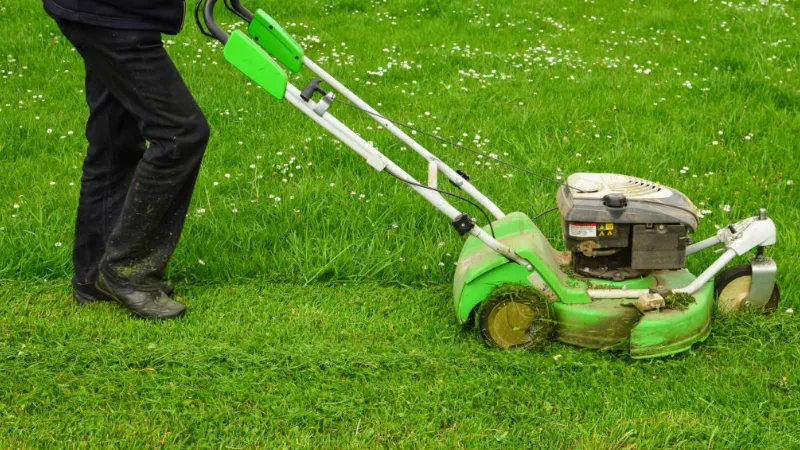Below will give you grass watering tips. Anyone who has ever worked on a lawn can attest that watering freshly planted grass seed properly is an essential step in developing and maintaining a healthy lawn. So, how often to water grass seed?
Until the soil is sufficiently moist and the grass has begun to grow, you should typically water your new grass seed twice a day. Continue reading.
How Often Do I Need to Water New Grass Seed?
For the first week after planting, you’ll need to water newly planted grass seed twice a day in the majority of climates. After this period, you only need to water your grass seed once per day because the top layer of soil will become moist and your grass should grow about an inch tall.
It is important to keep in mind that cool-season grass requires less water if you live in a colder climate. Conversely, if you are watering during the summer and have warm-season grass, your lawn might need more water. The amount of water your lawn needs is also influenced by the soil.
If you take a tiny screw and bury it in the ground, you can determine whether your grass has received adequate watering. If it emerges moist, the water is deep enough to adequately hydrate your lawn.

When to Water Your New Grass Seed?
Before you plant new grass seed, you should actually start watering your lawn. Soak your lawn in water for six to eight inches a few days prior to planting. This will moisten up the soil and help it breathe, meaning it will take up the seeds better.
Your lawn will require copious amounts of water after you sow grass seed to ensure that the seed takes root and sprouts. Thus, you should water your lawn relatively frequently right after you lay down seed. Two times a day, in the morning and the afternoon, is the recommended amount of watering for a freshly laid lawn, according to experts. In order for the new grass seed to firmly take root and begin to grow, you must maintain this regular watering schedule for at least two weeks.
How to Water New Grass Seed?
You might be tempted to water your fresh seed with a brand-new grass sprinkler. This is a good idea if you have a large lawn, but it’s not the best idea if you only have a small yard. You do not want to overwater your new lawn because it is difficult to control how much water a sprinkler emits.
Therefore, we advise manually watering plants with a hose. This will allow you to get even coverage of your yard and also control exactly how much water gets laid down. Spray water on each area of your lawn for 10 to 15 seconds. You should repeat this process about twice a day for the first few weeks until the grass takes root and starts to grow. Ideally, your newly laid lawn should get about 3″4″ of water twice per day.
Top watering tips:
How Long to Water New Grass Seed?
Before planting the seeds, thoroughly water the soil. 6 to 8 inches is a healthy amount of water for the soil several days before planting.
Keeping the soil moist is important when planting new grass seed. The new seeds will be choked by waterlogged soil. The grass seedlings should ideally be watered 2 to 3 times per day for 5 to 10 minutes each. By doing this, you can replenish any water that has evaporated without becoming overly saturated. 3–4 inches of water are consumed each week.
Once the grass seeds have sprouted, you should water once daily for a longer time. Watering needs to be done less frequently—starting with 2-3 days a week for a long soak of about 40 minutes on alternate days. To help the grass develop deeper roots, water should be applied after germination. Less frequent watering is necessary for this.
Observe the weather closely. You can determine how frequently to water grass seed by watching for showers and periods of heavy rain. After rains, don’t water the plants.
To automate this process, install a high-quality sprinkler system with a timer. Perhaps you don’t want to get up early on a Saturday just to water the lawn. How Long Does Grass Seed Last?

Essential Grass Seed Truth to Consider
Before they start to germinate, all seeds need moisture and a specific temperature range. The seed or new sprout is vulnerable and susceptible to death if conditions change after the germination process has started.
If the seed or sprout dries out — it dies. Therefore, it is your responsibility to always supply enough moisture. The most crucial time is just before any sprouts start to appear. Depending on the variety, grass seed can germinate in 5 to 30 days, and in colder climates, it may take even longer.
The roots are also spreading out into the soil as the new grass emerges. This takes place very quickly. The plant is less vulnerable now that roots can access soil moisture below ground. Reduce the amount of watering new grass seeds, but not yet. Remember: Not all seeds will sprout at the same time. Seeds may be buried at varying depths, absorb water in a variety of ways, or vary in quality or maturity. Many seed blends combine several varieties, each of which will have unique traits that will influence how the seeds develop.
Tips for the Best Results
- Before watering the new grass seed even once, cover it with mulch.
- Avoid the hottest season or occasional heat-spells when planting. It’s difficult enough to water new grass seed; the heat shouldn’t be made into an adversary. If you have no other option, keep an eye out and prepare to apply water more frequently as it dries out more quickly.
- There is too much moisture present if you start to notice moss or algae-like growths, especially in shady areas. Reduce the number of times you water and probably the duration as well.
- For small patch projects; some seed brands are coated with a covering that holds moisture. Although this strategy is efficient, it might be too expensive to consider for a sizable area.
- Don’t purchase a cheap lawn sprinkler. They frequently leak and produce puddles while not dispersing the water evenly. Companies that investigate and test their products to ensure adequate coverage must charge more.
(How much do seeds, mulch, and … cost you? Moreover, your time and labor are not included. Do yourself a favor and invest in a good sprinkler.) - Oscillating sprinklers are good for watering new grass seed in large areas where run-off is a concern. As opposed to a constant spray on all surfaces, the back and forth motion gives the product time to soak in.

FAQs
Best Time of Day to Water New Grass Seed
Mornings and evenings are the best time of day to water new grass. More water can be absorbed into the soil as a result of less evaporation.
What Makes Grass Grow Faster?
One of the most effective ways to get your grass to grow fast is to fertilize right after you plant.
What Grass Seeds Grow the Fastest?
Some of the fastest-growing grass types include Perennial Ryegrass, Annual Ryegrass, Fine-leaf Fescues, Kentucky Bluegrass, and Bentgrasses.
Should I Put Topsoil over Grass Seed?
Do not put top soil over grass seed, but you can add a thin layer of organic matter to help the seed to germinate. Never cover newly planted grass seed with topsoil. This will not create wholesome growing conditions; rather, it will effectively suffocate the seedlings, preventing them from sprouting.
Summary: How Often to Water Grass Seed?
A lush, green lawn not only looks great but also solves drainage, cooling, and landscaping problems. You must maintain a regular watering schedule for new grass seed in order for it to grow healthily. If you don’t water your newly planted grass seed often enough it can die, and you’ll need to start the process over. For you and your family to enjoy a happy and healthy lawn, a regular watering schedule is essential.
If you have any questions, please leave a comment. My Prime Home tries to give you the best home improvement information. Thank you for reading.



